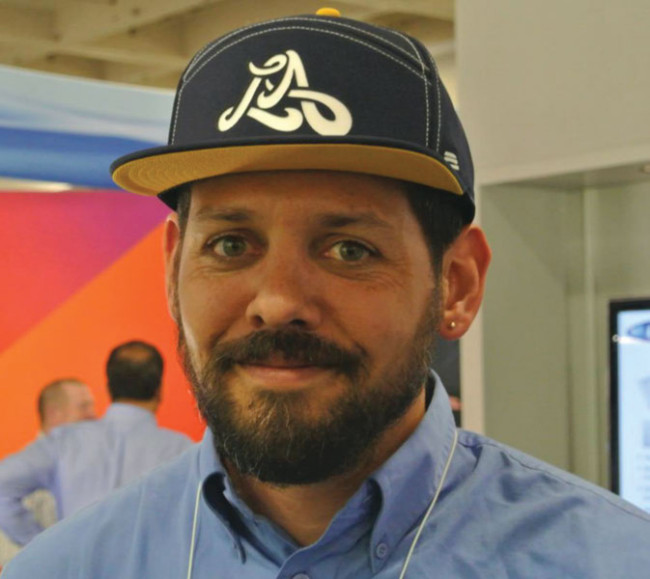At the 2016 National Hardware Show held in Las Vegas, May 4-6, the Kickstarter-funded company Alkilu (Los Angeles) won the New Product World Winner prize for aesthetics. The product, called TripLit, is a thin, lightweight camping lantern with a clamshell design. A large hanging hook is enclosed within the clamshell when it’s closed, and the clamshell can also be configured as an easel that stands alone.

The idea of portable OLED lighting seems obvious so I was surprised when Alikilu Founder and CEO Alex Khayat told me by phone on Tuesday that the TripLit the first portable OLED lighting product. An (admittedly quick) Googling supported his claim. (The Finnish lighting company Airam has sponsored OLED designs by students at Aalto University. One of them, called “Take along” by Anna Miia Suominen, is an OLED implementation of a “household storm lantern.” It’s a beautiful design, but it is not a product.)
Illustration and specifications for Alkilu’s TripLit camp light, which is to the best of our knowledge the first portable OLED lighting product. (Figure: Alkilu)
Back to the TripLit. Most portable lanterns use a cluster of LEDs, with some worklights using a flat array. It would take a 16-LED array, Khayat said, to match the TripLit’s luminous output, and the array would be less efficient, heavier, thicker, and would have more difficult thermal management issues. Khayat was quick to acknowledge that LEDs are ideal for projecting light (as in flashlights), while maintaining that OLEDs were ideal for providing ambient light. Amber OLEDs provide a pleasingly soft light, he said, that is now becoming popular. “The soft light attracts people and is the product’s wow factor,” said Khayat.
Among the light’s other characteristics is that it doesn’t attract insects because the OLED light source does not emit in the ultraviolet, Khayat said, and that the light lasts 30 hours or more per charge. The TripLit’s MSRP is $69.95, or it can be bundled with a solar charger for $129.95. The solar charger can also charge a mobile phone. The $69.95 price puts the TripLit in the upper half of the camp light price range, but it is not an outlier.
Khayat said Alkilu is selling the TripLit through several on-line retailers and is pleased with its sales. The company is now exploring arrangements with larger retailers.
Alkilu deserves significant credit for seeing an significant unfilled niche in the market and starting to fill that niche with a beautifully designed product. But the company’s initial success raises a question.
There are millions of flat lamps in the world made from LEDs and lightguide plates (LGPs), and they are well known to readers of this column. We call them backlights. Why hasn’t anybody used this configuration for portable illumination?
What about Backlights?
The configuration is used for permanently installed luminaires. Global Lighting Technologies (GLT; Brecksville, Ohio) has a 4×4-inch, 3.5-mm thick light guide intended to be edge-lit with industry-standard LEDs. The product “provides an efficiency of over 115 lumens/watt while producing up to 250 lumens when full powered,” GLT says.
GLT VP of Sales and Marketing Brett Shriver: “In many applications where designers are considering OLED, our light guide can provide proven performance at a lower cost. It’s less fragile and easier to handle, with excellent uniformity and a larger range of sizes.”
But GLT has no modules intended for portable lights. The company is no stranger to portable applications, being well known as a developer of LGPs for portable products incorporating displays. Current products include lightguides for wristwatches that are as thin as 0.25mm. The company is also making lightguides for clothing, including polycarbonate units as thin as 0.25mm that are used as backlights behind cut-out logos in baseball caps, which the company says are good sellers.
 At Display Week 2016 GLT VP Brett Shriver wore a Los Angeles logo hat that uses his company’s 0.25mm-thick polycarbonate lightguide lamp to illuminate the logo. Although the lamp appears to be lilt in the photo, it isn’t. (Photo: Ken Werner)
At Display Week 2016 GLT VP Brett Shriver wore a Los Angeles logo hat that uses his company’s 0.25mm-thick polycarbonate lightguide lamp to illuminate the logo. Although the lamp appears to be lilt in the photo, it isn’t. (Photo: Ken Werner)
But there is nothing intended for TripLit-style lighting. Why? That will be the next part of this story.
Ken Werner is Principal of Nutmeg Consultants, specializing in the display industry, manufacturing, technology, and applications, including mobile devices and television. He consults for attorneys, investment analysts, and companies re-positioning themselves within the display industry or using displays in their products. You can reach him at [email protected].

